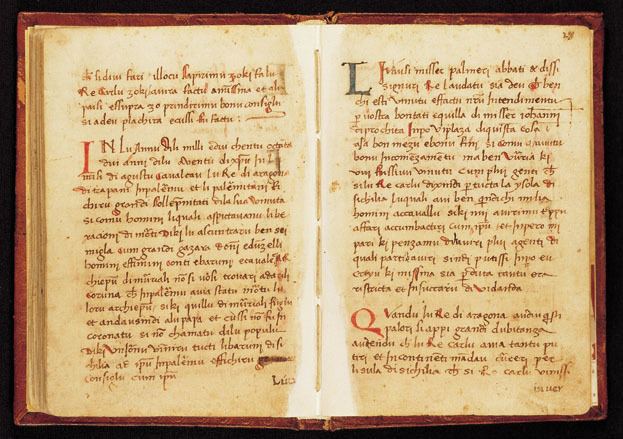 | ||
Lu rebellamentu di Sichilia, fully Cronica di lu rebellamentu di Sichilia contra re Carlu, is a Sicilian historical chronicle of the War of the Vespers written around 1290. The anonymous Rebellamentu, probably written at Messina, was ascribed to Atanasiu di Iaci by Pasquale Castorina in 1883. Though the Rebellamentu sometimes adds valuable details to the history of the Vespers, it is frequently untrustworthy. Its monastic provenance is evident in its moralising tone. The antiquity of its language has placed its authenticity beyond doubt, despite its lack of an early manuscript tradition. This has not prevented speculation that it was written contemporarily with events: one verb in one manuscript is found in the first-person present; this may represent the author inadvertently stepping out of his usual frame of reference, or merely an error in that manuscript.
The Rebellamentu covers the years 1279–82 and treats John of Procida as a hero. It is also the earliest chronicle to record that violence broke out after a Sicilian woman was raped by a French soldier, a story also recorded by Atanasiu di Iaci elsewhere. It says that when the Sicilians complained to Charles of Anjou about their high taxes, he responded, "Vi farro spendiri munita di soli, como altra volta havitu spisu," threatening that he would re-issue leather money as had been done in the past. This probably indicates that the legend that William I issued leather money, otherwise first recorded by Tommaso Fazello in his De Rebus Siculis (1558), was current in the late thirteenth century. The Rebellamentu also makes the Orsini Pope Nicholas III party to a conspiracy to dethrone Charles of Anjou. The Florentine chronicler Giovanni Villani, who was biased against the Orsini because of the legation of Napoleone Orsini to Florence in 1306, supports the allegation.
The Rebellamentu covers John's negotiations with the Byzantine emperor Michael VIII Palaeologus and with Peter III of Aragon, the Sicilian Vespers, the coronation of Peter in Palermo in August 1282, the retreat of Charles to Calabria, and the entry of Peter and John into Messina in October 1282. The excerpt below describes how Peter was crowned by the Bishop of Cefalù because the incumbent of the Archdiocese of Palermo, Piero II de Santa Fede, had recently died, and the Archbishop of Monreale, Giovanni Roccamezza, was away in Rome:
Two later Tuscan histories of the Vespers—the Liber Jani de Procida et Palialoco and the Leggenda di Messer Gianni di Procida—may share the Reballamentu as a source. Conversely, all three may derive from an earlier, now lost source. All three agree on the centrality of John of Procida in the Vespers. The opera Les vêpres siciliennes (1855), with music by Giuseppe Verdi and a libretto by Eugène Scribe, drew upon the Rebellamentu for elements of its story, notably the rape.
